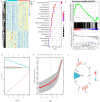Baseline SUVmax is correlated with tumor hypoxia and patient outcomes in nasopharyngeal carcinoma
- PMID: 39215035
- PMCID: PMC11364769
- DOI: 10.1038/s41598-024-71191-y
Baseline SUVmax is correlated with tumor hypoxia and patient outcomes in nasopharyngeal carcinoma
Abstract
To evaluate the prognostic significance of the maximum standardized uptake value (SUVmax) in nasopharyngeal carcinoma (NPC), establish a gene signature that correlates with SUVmax, and explore the underlying biological behaviors associated with these correlations for the prediction of clinical outcomes. A cohort of 726 patients with NPC was examined to identify correlations between SUVmax and various clinical variables. RNA sequencing was performed to identify genes related to SUVmax, and these genes were used to develop an SUV signature. Additionally, transcriptome enrichment analysis was conducted to investigate the potential biological behaviors underlying the observed correlations. Higher SUVmax was associated with an increased tumor burden and worse prognosis. The SUV signature, which consisted of 10 genes, was positively correlated with SUVmax, and it predicted worse survival outcomes. This signature was highly expressed in malignant epithelial cells and associated with hypoxia and resistance to radiotherapy. Additionally, the signature was negatively correlated with immune function. SUVmax is a valuable prognostic indicator in NPC, with higher values predicting worse outcomes. The SUV signature offers further prognostic insights, linking glucose metabolism to tumor aggressiveness, treatment resistance, and immune function, and it could represent a potential biomarker for NPC.
Keywords: Glucose metabolism gene; Hypoxia; Nasopharyngeal carcinoma; Patient prognosis; SUVmax.
© 2024. The Author(s).
Conflict of interest statement
The authors declare no competing interests.
Figures





Similar articles
-
Clinical Outcome-Related Mutational Signatures Identified by Integrative Genomic Analysis in Nasopharyngeal Carcinoma.Clin Cancer Res. 2020 Dec 15;26(24):6494-6504. doi: 10.1158/1078-0432.CCR-20-2854. Epub 2020 Sep 28. Clin Cancer Res. 2020. PMID: 32988965
-
microRNA-342-3p targets FOXQ1 to suppress the aggressive phenotype of nasopharyngeal carcinoma cells.BMC Cancer. 2019 Jan 24;19(1):104. doi: 10.1186/s12885-018-5225-5. BMC Cancer. 2019. PMID: 30678643 Free PMC article.
-
High miR-3650 expression in nasopharyngeal carcinoma and its clinical prognostic values.Pathol Res Pract. 2021 Aug;224:153506. doi: 10.1016/j.prp.2021.153506. Epub 2021 May 30. Pathol Res Pract. 2021. PMID: 34091390
-
Exploring Programmed Cell Death-Related Biomarkers and Disease Therapy Strategy in Nasopharyngeal Carcinoma Using Transcriptomics.Front Biosci (Landmark Ed). 2024 Jun 27;29(7):240. doi: 10.31083/j.fbl2907240. Front Biosci (Landmark Ed). 2024. PMID: 39082346
-
Research status and prospects of biomarkers for nasopharyngeal carcinoma in the era of high‑throughput omics (Review).Int J Oncol. 2021 Apr;58(4):9. doi: 10.3892/ijo.2021.5188. Epub 2021 Mar 2. Int J Oncol. 2021. PMID: 33649830 Free PMC article. Review.
References
-
- Zhang, L. et al. Gemcitabine plus cisplatin versus fluorouracil plus cisplatin in recurrent or metastatic nasopharyngeal carcinoma: A multicentre, randomised, open-label, phase 3 trial [published correction appears in Lancet. 2016 Oct 15;388(10054):1882]. Lancet388(10054), 1883–1892 (2016). 10.1016/S0140-6736(16)31388-5 - DOI - PubMed
MeSH terms
Substances
Grants and funding
- 2023Y9427/This work was supported by research projects for the the Fujian Province Joint Funds for the Innovation of Science and Technology
- 2023Y9409/This work was supported by research projects for the the Fujian Province Joint Funds for the Innovation of Science and Technology
- 2022YNG02/Fujian Provincial Cancer Hospital Talent Development Program
LinkOut - more resources
Full Text Sources

